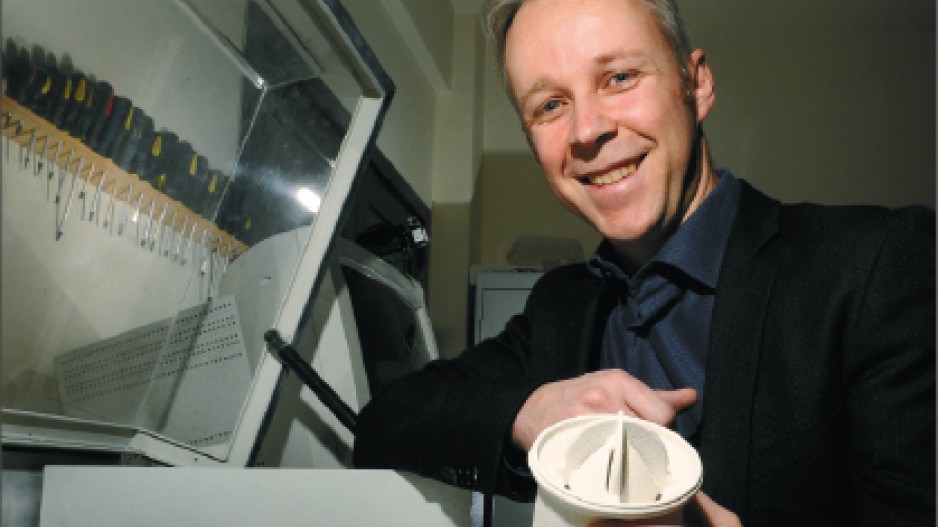Future engineers are using futuristic technology to print prototypes in three dimensions at UBC.
The university bought three Objet 3D printers last summer, said Leo Stocco, a senior instructor with UBC’s department of electrical and computer engineering.
One of his first uses of the machines was to assign his second-year students to design and build components for a mechanism that would move a row of LEDs back and forth.
In the past, his students would have had to use a water-jet cutter or machining tools like lathes and drill presses to create such components. It was time-consuming and required a lot of mechanical expertise.
“But with a 3-D printer you can do really complicated things, really small things,” Stocco said. That makes it “a really useful technology for somebody who has absolutely no machining skills to make a perfect part,” he added. “And it’s done in a couple of hours.”
A form of rapid prototyping, 3-D printing uses software instructions to “print” objects in three dimensions. The Objet printers, and others like them, are actually based on two-dimensional inkjet printer technologies.
Other types of 3-D printing include
•fused-deposition modelling (FDM), in which layers of plastic are fused under ultraviolet light; and
•selective laser sintering (SLS), which involves lasers and can make even make metal parts.
The machines range in cost from a MakerBot Thing-o-Matic kit, which costs US$1,099, to a high-end machine will fetch $300,000 or more.
“It’s definitely an up-and-coming thing,” said Stocco, whose department received a grant of about $100,000 to pay for the three printers and for an assistant to help with training.
For 3D Reverse Engineering of Langley, the future of 3-D printing arrived in November in the form of a $150,000 Fortus 360MC.
The size of a large refrigerator, the machine was too big for company owner Matthew Percival’s home-based office. So he keeps it at Dependable Industries in Surrey, where he and Dependable owner Gary Amstutz operate a rapid-prototyping service bureau.
The Fortus uses the fuse deposition technology and can print with two materials, ABS and polycarbonate.
It can build things as large as about half a metre on each side. Printing an item the size of a computer mouse would take about five hours and, depending on the number of pieces, cost about $300.
“That’s cheaper than buying an injection mould for a part you’re not sure [about],” Percival said. Such a mould can cost tens of thousands of dollars, depending on the complexity.
So far, the Fortus has made such items as components for foundry tooling, sales models for the pulp and paper industry, and pieces of automotive equipment.
“I’ve had requests for replacement parts for antique pinball machines,” he said.
He has also done prototyping for engineers but could not be more specific, citing non-disclosure agreements.
“The goal is to have that automated system to have it run 24 hours a day,” Percival said. “It’s lights out, right. You send a part to it and it might take 100 hours to print and you’re done.”
At JDi Design Inc. in Burnaby, the future of 3-D printing arrived six or seven years ago when the company bought a demo Z Corporation Z402 printer for about $55,000. Owner Adrian van Wijk, an industrial designer, even established a separate company, Key3D.com, to process 3-D printing and other rapid prototyping orders.
He said the machine is showing its age, and has paid for itself, but he is hesitant to upgrade to a more modern one because the technology is advancing so rapidly.
“And the market space has become so competitive because there are so many technologies and so many options,” he said.
Van Wijk also noted that he was a designer long before the era of rapid prototyping. Twenty years ago, he said, he would have to sculpt and cut materials painstakingly by hand to craft the prototypes used to make the injection moulds. “It used to take a month or six weeks to make a prototype, whereas today, yeah, it’s a day,” he said.
He still receives three or four requests a day for 3-D printing. That includes a spurt of orders from a customer who is designing a clip for holding a cable to charge an electric lawnmower or vacuum cleaner.
“He’s made four or five iterations of his prototype,” van Wijk said.
On the other hand, van Wijk recently put together a quote for someone who thanked him politely for his efforts but decided instead to use a 3-D printer at Emily Carr University of Art + Design.
“They’re going to charge me $50,” the person informed him.
While van Wijk says 3-D printing has already reached its tipping point, but a future where people shop online and print their products at home is still a long way off.
“But, you know, if that gets critical mass and a lot of hobbyists start using them, and kids start printing out school projects, yeah that’s a catalyzing change.” •




